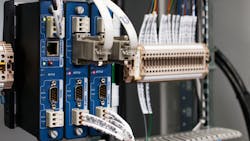A Programmable Logic Controller is “a small industrial computer originally designed to perform the logic functions executed by electrical hardware (relays, switches, and mechanical timer/counters),” as defined by The U.S. Department of Commerce National Institute of Standards & Technology (NIST).
PLCs have evolved to control complex processes and are used in supervisory control and data acquisition (SCADA) systems and Distributed Control Systems (DCS). PLCs are used in almost all industrial processes.
What Are the Benefits of PLCs?
According to NIST, PLCs have user-programmable memory for storing instructions for specific functions, including I/O control, logic, timing, counting, three mode (PID) control, communication, arithmetic, and data and file processing.
Unlike SCADA and DCS, PLCs usually do not have a central control server and HMI and, therefore, they “primarily provide closed-loop control without direct human involvement.”
This kind of automation allows engineers with a limited knowledge of computers and computing languages to operate the systems easily, as PLCs are generally considered intuitive.
Other benefits noted by NIST are that PLCs “withstand vibrations, temperature, humidity and noise; and have interfacing for inputs and outputs already inside the controller.”
What Are the Components of PLCs?
According to NIST, the components of the PLCs are:
- The processor unit or central processing unit (CPU), or the unit containing the microprocessor that interprets the input signals and carries out the control actions.
- The power supply unit, which converts the mains AC voltage to the low DC voltage.
- The programming device, which is used to enter the required program into the memory of the processor.
- The memory unit, where the program is stored that is to be used for the control actions to be exercised by the microprocessor and data stored from the input for processing and for the output for outputting.
- The input and output sections, where the processor receives information from external devices and communicates information to external devices.
- The communications interface is used to receive and transmit data on communication networks from or to other remote PLCs.
What Are the Main Types of PLCs?
The main types of PLCs are compact PLCs and modular PLCs.
Compact PLCs
According to BasicPLC, the compact PLC input and output (I/O) are integrated into the microcontroller itself. Every type of input or output is fixed, so it does not have the capability to expand the modules.
Modular PLCs
A modular PLC generally looks like a rack in which multiple modules can be fitted. This allows multiple expansions of the system and gives the PLC additional features such as an increased number of I/O units. Modular PLCs are usually easier to use because each component is independent of each other, meaning operators can troubleshoot by isolating modules.
In addition to the I/O modules, these types of PLCs generally have an independent power supply as well as a communications module. As such, modular PLCs tend to offer more flexibility than compact PLCs.
Modular vs. Compact PLC: Which is Best?
Between modular and compact PLCs, the modular PLC is preferred, especially for large industrial systems because they often contain a lot of devices with I/O that also need to be controlled. Factors often considered when choosing a PLC include scalability, number of I/O, fault detection, downtime, module combinations, and memory.
